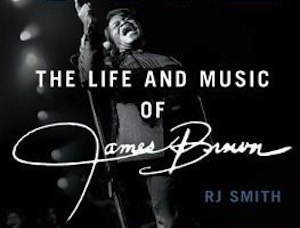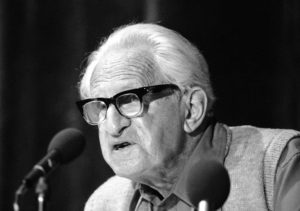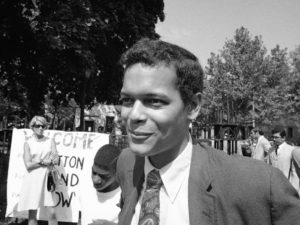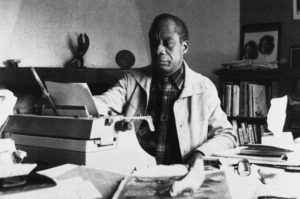Ain’t It Funky
When Bootsy Collins defected from James Brown's band for George Clinton's, RJ Smith, in his new biography of Brown, gives us the desertion from Brown's point of view: "You could not copyright a beat, a smell, the One. You made it and then a younger man in an ass-length blond wig marked it up and made it new."
“The One: The Life and Music of James Brown” A book by RJ Smith
Mythic and imperious, James Brown ranks as one of the last century’s most important acts, defying musical gravity along with Louis Armstrong, Jimi Hendrix and perhaps Ray Charles. Since his death in 2006, Brown looms over soul, funk and rap more as symbol than musician, a simplification and oversight that RJ Smith corrects on nearly every page of his radiant new biography.
Smith, a former Village Voice music critic and author of “The Great Black Way,” a nuanced history of the Los Angeles R&B scene, argues that Brown’s nasty shouts atop even nastier rhythmic turns made descriptors like “soul,” “funk” and “jive” vastly inadequate. Smith reaches beyond superlatives for evocative descriptions like this: “Other artists made things, but Brown made experience — he was a verb, and his true medium was us.”
As a boy, Brown traveled down a backwoods Jim Crow road, an abandoned youth in trouble early and often. He was jailed at 16, just young enough to resolve never to depend on anybody again. And as he turned his hardship into crossover gold in the early 1960s, the civil rights movement turned him from trailblazer into Republican “entrepreneur.” Smith draws this central irony of Brown’s career — progressive styling built on a conservative work ethic — with grudging sympathy.
Brown’s rhythms flowed from hardship. He was a child of rural South Carolina’s cotton and vegetable fields. His family said he was “stillborn,” brought back from the brink by his Aunt Minnie. She blew breath into his infant lungs after “infinite minutes” of uncertainty. “He saw his stillborn entrance as the moment his specialness first manifested itself,” Smith writes. The very story of his birth fueled his immense ego. “One good thing about believing you were born dead is you come to feel nothing can kill you,” Smith observes.
|
To see long excerpts from “The One” at Google Books, click here. |
Smith traces Brown’s cultural lineage back to the Stono Rebellion of 1739, when 20 slaves broke into a Charleston, S.C., warehouse and marched for Spanish Florida, killing sentries along the way. Stono was the largest revolt to disrupt the colonies in the 18th century. The drums of the rebelling slaves, fueling their singing, dancing, swaying and marching, led to the banning of drums by the Slave Code of 1740. In Smith’s telling, the Stono drums became a weapon, a Congolese tradition, the “original form of broadcasting,” suddenly revived as “nothing less than a call to war.”
So Brown’s myth, his idea of himself as a sentinel for justice, emerged long before his music. His mother disappeared when he was about 4 years old, and he traveled with his father selling Applejack moonshine, picking up stray harmonicas and meeting local legends like Tampa Red, who wrote “Turpentine Blues.” Around age 6 or 7, Brown and his father settled near Augusta, Ga.
Brown came of age on Twiggs Street in a place known as Georgialina, along the Savannah River. His Aunt Honey had a whorehouse on Twiggs Street. Honey shoved Brown into the closet when clients would visit, and he knew not to sneak out. Once, when he did, he was tied in a croaker sack, hung from the ceiling and beaten with a belt.
Another defining incident came when Brown accidentally leaned back on an air compressor in his Daddy’s garage. He short-circuited the machine, sending jolts of electricity through his veins.
“His shoes started smoking,” Smith writes. “He could not let go. It seemed like minutes passed while the men did nothing. His mind went to a place past agony, and he felt a sickness, a feeling like a balloon was filling up inside him. The feeling he had wasn’t painful; he was flooded with a sense of invulnerability.” Along with his miraculous birth, those roughly four minutes of sustained shock “cemented his sense of destiny.”
In 1949, police picked up the 16-year-old Brown for breaking into four cars. He was thrown in prison on two consecutive terms of four years’ hard labor. There he met one Bobby Byrd of the Gospel Starlighters, who ultimately sponsored Brown’s release on good behavior in 1952.
In his first band, the Flames, Brown played the drums. He had internalized those Stono drums, organizing his musical ideas around the call of The One, which meant far more than the downbeat in the music: “… Like the drip to Jackson Pollock or the footnote to David Foster Wallace, for Brown The One was bigger than it first appeared, a trifling that embodied the world he made,” Smith writes.
This is how Brown himself put it: “The ‘One’ is derived from the earth itself, the soil, the pine trees of my youth. And most important, it’s on the upbeat — ONE two THREE four — not the downbeat, one TWO three FOUR, that most blues are written. Hey, I know what I’m talking about! I was born to the downbeat, and I can tell you without question there is no pride in it. The upbeat is rich, the downbeat is poor. Stepping up proud only happens on the aggressive ‘One,’ not the passive Two, and never on lowdownbeat. In the end, it’s not about music — it’s about life.”
Passing through town one night, Little Richard heard the Flames and helped connect Brown to King records in Cincinnati. Brown was struck by Richard’s astonishing bouffant, “tent-show queen” hairdo, and mixed the style with “croquignole” curls for a look he called “expoobident,” hipster lingo that meant “tight, neat, glorious.” The consummate professional serving his own image, Brown had his hair done in the morning, again before a show and then again after. “James Brown loved his hair better than he loved his women … ” one associate said. Brown’s rough 1956 debut for King records was nothing but a sprawling, naked cry of lust, scornful of any decency or acceptability. It had a tantalizing effect on listeners, and King’s owner, Syd Nathan, seemed both repelled and enchanted by it. Smith sees Nathan as a complicated creative genius and civil rights trailblazer, the kind of businessman who ran an interracial company “with chili stains on his tie.” On his recording debut, Nathan cemented Brown’s indomitability: The label reframed the act as “James Brown with the Famous Flames.”
Brown’s life bounces atop the wildest showbiz stories imaginable. For long stretches, there’s a honker on every page. When Howlin’ Wolf saw the Flames do “Please Please Please,” he advised Brown that “if he wanted to keep on living in these clubs, he better stop crawling around looking up women’s dresses while he sang his song.”
One of his many wives, Betty Jean Newsome, reflected on how Brown abused both musicians and women:
“The Flames covered their eyes when he looked like he was gonna hit me. I told them don’t bother closing your eyes because HE the one that’s gonna be getting hit. I said, ‘What kind of men are you that you be so afraid of him?’ They were scared stiff. He used to hit them grown men? It was crazy, it was pitiful the way that he treated them. He was something, boy.”
And all through the many road stories, contract disputes, girlfriends, tyrannical punishments and sexual metaphors he handed out to his players over the years, Brown honed his sound. It was constantly changing yet increasingly personal and innovative, and it led to the enormous eruptions of soul into funk and funk into rap. Smith identifies key players in this story, drummers such as Clayton Fillyau (“Biggun”), John “Jabo” Starks and Clyde Stubblefield, and bassists such as Hubert Perry and Bootsy Collins.
Collins famously defected from Brown’s band in the early 1970s to join the eccentric George Clinton’s Parliament, and took the secrets of Brown’s rhythms to ignite the new glory: funk. Smith gives us this transition from Brown’s point of view: “That is how it worked. You could not copyright a beat, a smell, the One. You made it and then a younger man in an ass-length blond wig marked it up and made it new.”
Part of Brown’s genius lay in his bandleader role. As frontman, he was vocalist, dancer, arranger and orchestrator of everything he beheld, including his audience. Brown sang each individual part to every band member, and then counted down to see what would happen. He was as much a control freak as he was a free-jazz chance artist. On records like 1964’s “Out of Sight” and “Papa’s Got a Brand New Bag,” Brown nailed the new stylistic synthesis. On such tracks, Smith writes, Brown
“seemed to pull apart the elements of the band and scatter them around, making their relationships visible, like an exploded-view diagram. The bass was doing things it hadn’t done before in pop music, and was perhaps the most active part of either song. It was mobile and so low you had to move in to hear it — a sound carrying information you could only partly absorb. … Stark and cinematic, the music created a new kind of space. It was survival rhapsodized as style — and as style it took off.”
Brown “imploded the air around him with a nod, as dominant at rest as he was with his marathon exertions,” Smith writes.
This power eventually consumed him. His final decades were a long, slow decline: a gnarly, erratic tour through angel dust, IRS disputes, domestic abuse charges and scary mug shots. And even this period features megalomaniac letters to presidents demanding tax forgiveness.
Brown never quite embraced Martin Luther King Jr., but he seemed to sense that his music’s symbolic power paralleled King’s agenda. “White folks, some young white folks, run AWAY from America,” Brown once said. “They ashamed. Black folks, they run all over, up North, everywhere, tryin’ to get INTO America.” Brown famously prevented Boston from dissolving into riots the night after King’s killing in 1968, when he performed live on television there at the mayor’s bidding.
Two years earlier, Brown had appeared at the King march that pulled into Jackson, Miss., on June 24, 1966. King noted the celebrities on the bill, which included Harry Belafonte, Sammy Davis Jr. and Marlon Brando. But when King saw James Brown’s name, he said simply, “I’m sorry, y’all. James Brown is on, I’m gone.”
NPR critic Tim Riley’s most recent book is “Lennon: The Man, the Myth, the Music — The Definitive Life.” He teaches journalism at Emerson College in Boston and runs Rileyrockindex.com.
Your support matters…Independent journalism is under threat and overshadowed by heavily funded mainstream media.
You can help level the playing field. Become a member.
Your tax-deductible contribution keeps us digging beneath the headlines to give you thought-provoking, investigative reporting and analysis that unearths what's really happening- without compromise.
Give today to support our courageous, independent journalists.









You need to be a supporter to comment.
There are currently no responses to this article.
Be the first to respond.